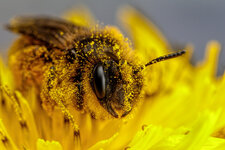Of all the factors that a photographer can control, the ability to control lighting would by far be one of the most important. In other style of photography like landscape the photographer will hunt for that just perfect golden hour lighting to light up their scene just right, of course they could take a photo in different lighting conditions but that is a compromise most times, from my own experience even a rather boring landscape transforms into something special under the right lighting conditions.
In Macro the ability to add light becomes even more important for the simple reason that in order to capture most subjects at 1:1 magnification or more we must narrow our f/stop in order to have enough depth of field. Stepping down from what is normally a sufficient f/stop for other style of photography (eg. f/4) to what is required for 1:1 macro photography (eg. f/11 +) means that you have to get that light back somehow for a proper exposure. Raising your ISO is the worst solution and last option, so what is left? increase shutterspeed? maybe if you have a static scene and a tripod. This leaves only flash or another external light source as solution and as you will see there are much more reasons to choose one of these, as they do much more than simply add light...
A flash freezes action; if you have ever been to some party, club, etc where they were using a strobe light you may have noticed that the strobe freezes people for a short period after the strobe fires, it makes it look as if everyone freezes mid dance move. Flash does the same thing. I have an active little dog and when I wanted to learn about flashes one of the first things i tried was to see if i could a get a shot of her in action - My shutterspeed dropped from over 1500/sec with no flash to 200/sec to completely freeze her mid air, side effect of this was the ability to sharply drop my ISO and therefore lower the noise in the photo.
A flash creates sharpness; I do a lot of photography where I need to turn off lights in order to achieve the result I am looking for, one of the most frustrating things about this is when I KNOW I have hit sharp focus only to get a photo that did not look sharp at all, lights back on, take another shot and its sharp, what is going on here?!?!

Cameras, just like our eyes do not see objects but rather the light reflected from them, more light means more definition. More light also means you get to trade in noise and allow you to use the narrower fstop that are needed in macro.
Flashes also opens your choices to off camera flash later on which is in itself a very handy technique to learn for all types of photography. A good LED torch or light panel works well too but be careful of the blueish hue that LED can give, altering your white balance to compensate for this can change the tones in your photos in ways you may want to avoid. I use 1/2 CTO (Colour Temperature Orange) Gel sheet 205 on my LEDs to avoid white balance issues in post.
There are times when a flash isn't needed like if you have a backlit image and you want a silhouette, if your not shooting macro at close proximity you dont need flash as you dont need to narrow down your fstop in order to get the DOF required to capture your subject or maybe your doing UV photography like me where any external light will dim the fluorescence. But overall these scenarios are in the minority of most macro scenarios.
I would love to hear about some of your opinions about this as I believe its one of the most re-occuring themes I see on macroderie, which is the reason I decided to write this post in the first place.
I will finish by telling you what my experience with and without a flash has been - My camera brand is well known for its low light capabilities and the last thing I wanted was to spend more money on another piece of equipment, not to mention the time to learn how to use it, extra weight, etc, etc. Why would I need it with a camera that performs so well in low light? Fast forward to nowdays where I still beat myself up for not having entered into flash photography earlier, wasted time. To date no other single purchase (not even top brand lenses) has had a greater positive impact on my macro photography, I cant recommend it enough to anyone who wants to raise the bar in their macro journey.


